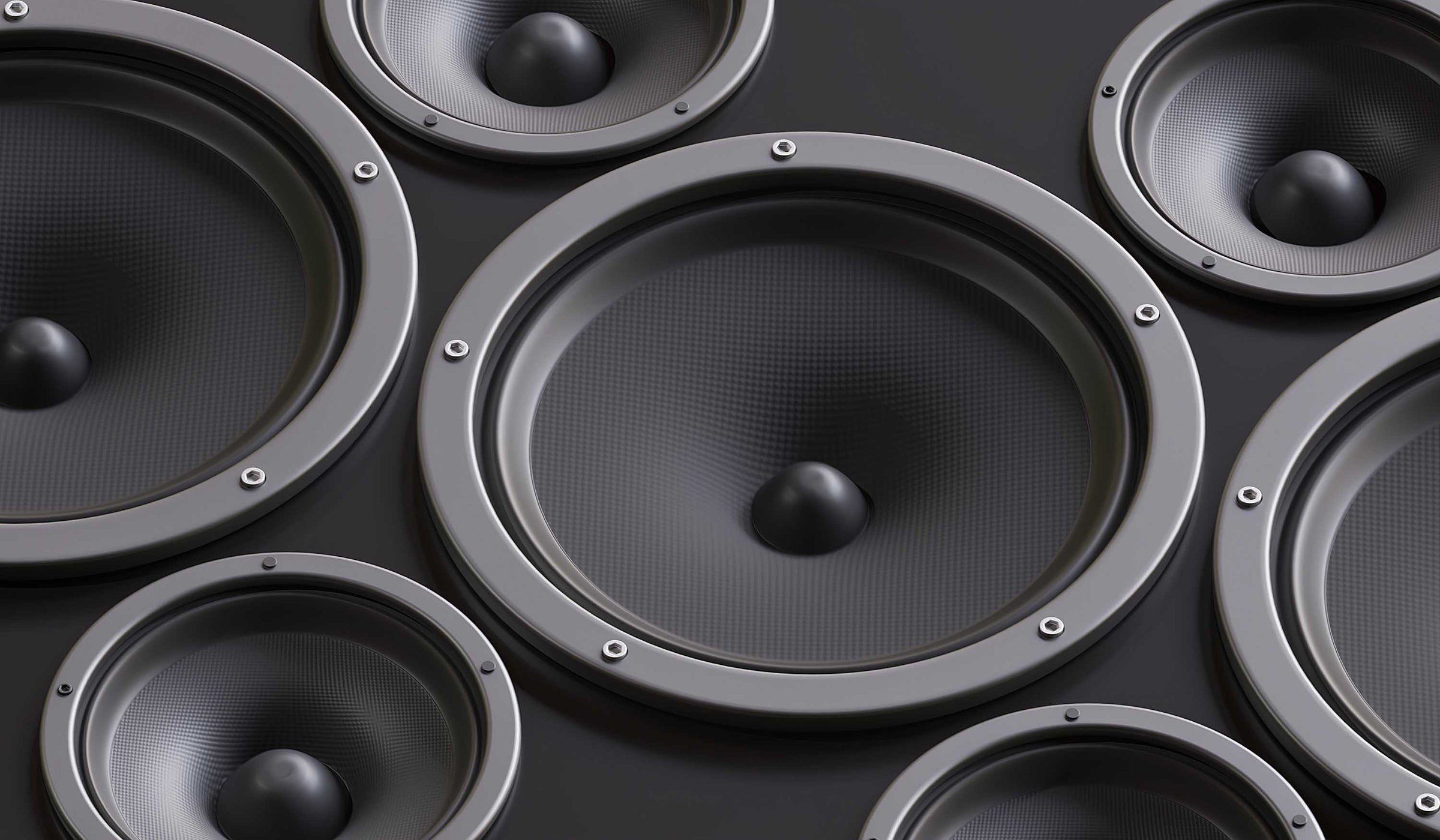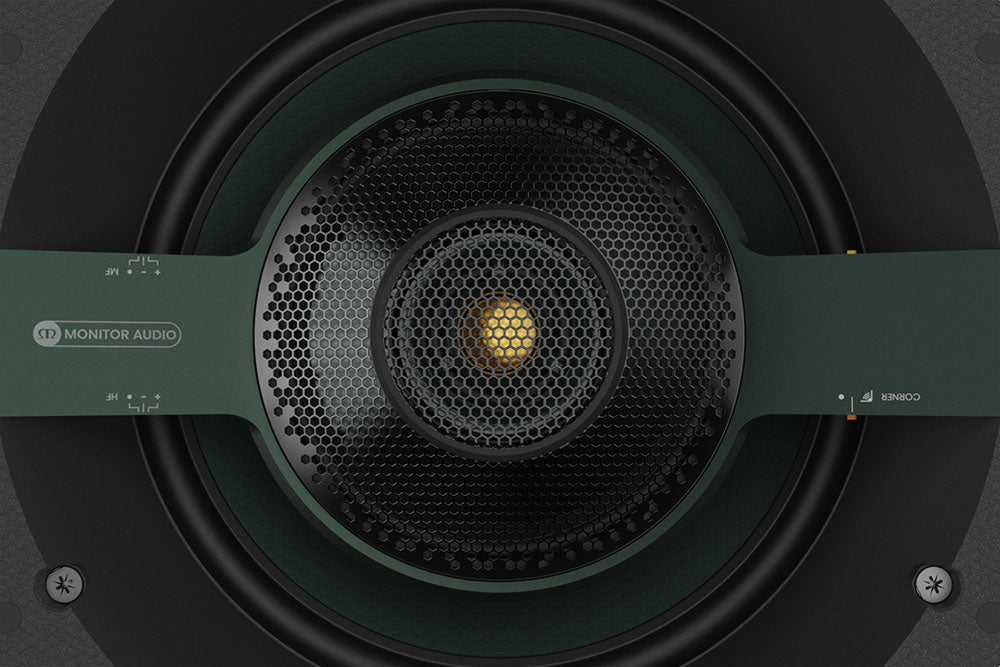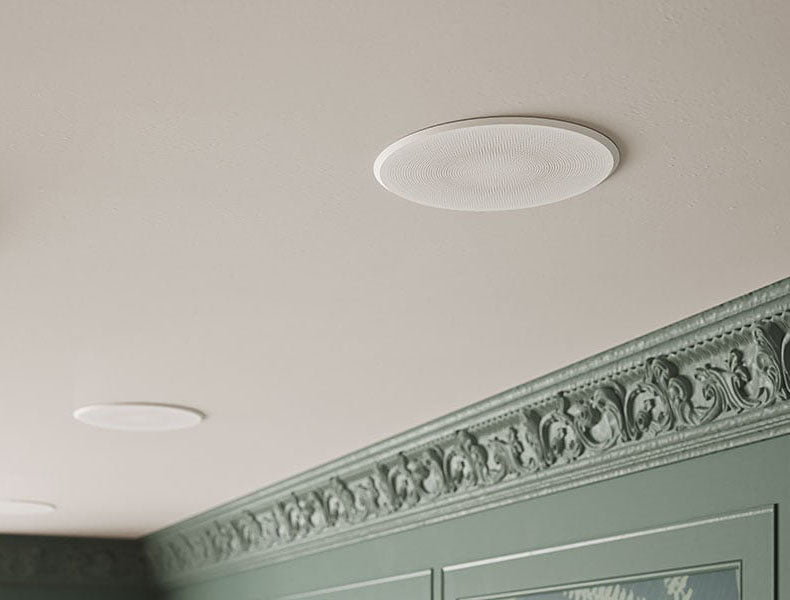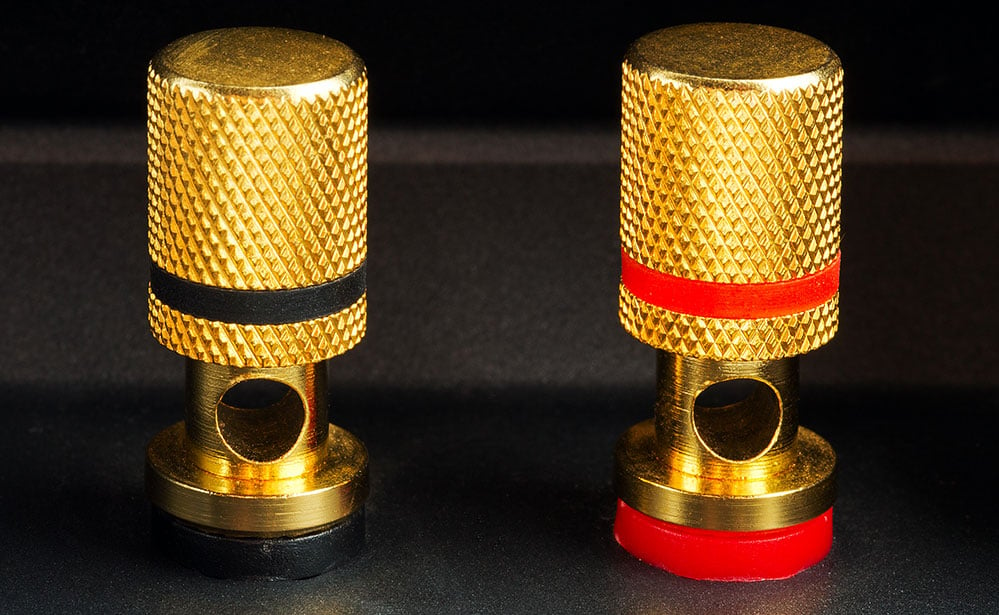
Frequently Asked Questions
We're here to help, so please contact us if you need any assistance. But here are some common questions that we are often asked.
Purchasing Advice
We want to make sure that you get exactly the right products for your requirements first time, and we understand that every project is different, so if you need any help please get in touch. But here are some common questions that we are often asked.
Fire hoods, or fire rated back boxes, are a requirement under UK Building Regulations to maintain the fire integrity of the ceiling where speakers are installed below habitable spaces or in areas of escape (ie. a landing or hallway). If the area above a speaker is an uninhabited loft or roof space, then a fire hood may not be necessary. However, Building Regulations are open to a certain amount of interpretation, so in the interests of fire safety and slowing the spread of fire, it could be argued that all in-ceiling and in-wall speakers require hoods. If in doubt always fit a fire hood.
In addition to fire safety, speaker hoods do have additional benefits which should not be overlooked, even if they aren’t strictly required under UK Building Regulations…
1. Fire & acoustic hoods are constructed using sound absorbing materials which help to reduce sound transmission to adjacent rooms and outside.
2. Fire hoods create a specific volume of air around the back of a speaker which acts as a ‘cabinet’ and helps to increase acoustic performance by improving bass extension and dynamics.
3. A hood protects the speaker driver and electronics from debris, dust and vermin damage which could reduce performance over time.
We’re here to help, so if you need any assistance please get in touch. Our team are all experienced AV professionals with many years of experience in both sales and installation. However, there are a few basic considerations when it comes to selecting the right speaker.
Will they fit? - If possible check the installation depth and cut-out size. Although most typical modern constructions will be fine (eg. 200mm deep timbers with 400mm centres), this can and does vary. For example, properties built with concrete floors and suspended ceilings may have a very shallow ceiling void. In a case like this a specialist low profile speaker may be required.
What speaker type? - The type of speaker will depend on the application. Most speakers can be used for music as well as AV and home cinema applications. But some speakers are better suited for one or the other, and a few are specifically designed for home cinema and surround sound. But for music systems powered by products like the Sonos Amp, we typically recommend a standard 6" or 8" speaker.
Is size important? - Driver size is very important when it comes to bass performance. Typically, the bigger the main driver size the better the low frequency response. The majority of speakers usually have 6” or 8” drivers, and most manufacturers will have the same model available in both sizes. It is recommended to fit 8” driver speakers in larger spaces to provide optimum bass performance and good dispersion. Smaller spaces, for example a bedroom or office, will often be fine with 6” driver speakers, but if maximum bass performance is important then always fit 8” models. It should be noted that while speaker sizes are often expressed in inches, this refers to the main driver size and not the overall diameter. A typical 6” speaker will have an overall diameter of around 240mm, and a typical 8” model will be around 280mm.
How much do I need to spend? - That is a very difficult question, especially as quality is always subjective. But as with most things, price dictates performance, so the more you spend on a speaker the better it will sound. More complex designs and higher quality materials all contribute to a speaker with a more refined sound. Manufacturers spend a lot on research and development to ensure that their models perform as well as they can for a specific budget. Custom install speakers can sound just as good as freestanding speakers, but care should also be taken to install fire/acoustic hoods or back boxes, and position them correctly to achieve maximum performance. Even a good quality speaker can sound poor if incorrectly installed. For further information, please see our blog on Getting the best from your custom installation speakers
Most rooms will need 1, 2 or 4 speakers depending on the size of the area. Here are some typical examples. The important thing to remember is that a stereo amplifier must be loaded evenly on both left and right channels. So you can’t have 3 mono speakers connected to a stereo amplifier for example. A single speaker is possible, but it must be a special single stereo model which has both left and right inputs. If in doubt please get in touch.
Small Room (eg. bathroom, en-suite, office) - In a small room you may not have the space to locate a pair of speakers, especially when you take into account other fittings such as lighting and extraction. In this case a single stereo speaker can be used. Single stereo models have one main driver but two tweeters. This provides a partial stereo output from a single unit. The important thing to remember about single stereo speakers is that they have separate left and right inputs. Therefore it is necessary to run a 4-core cable or 2x 2-core cables to this type of speaker. One of the most common mistakes that customers, electricians and installers make is to treat a single stereo model like any other speaker and only run a single cable to it.
Medium Room (eg. bedroom, dining room, living room) - A typical medium sized room such as a bedroom with an area up to approximately 20m² is best with a pair of 6” or 8” driver speakers. If using very compact speakers with small drive units then 4 might be required, but typically 2 regular sized speakers is the best solution.
Large Room (eg. open plan kitchen/dining room or large lounge) - Large open plan areas will likely require 4 speakers (two stereo pairs). This is partly to ensure that there is good audio coverage, but it will also provide two stereo listening zones in situations where the room is divided into kitchen/dining or kitchen/family areas for example.
There are specialist multi-channel amplifiers which can power multiple rooms (or zones), however popular streaming amplifiers like the Sonos Amp are stereo amplifiers which are only designed to drive a single zone. Sonos, and similar systems, are modular multiroom audio products which means that you need one device for each room.
In some circumstances you can use a single amplifier plus a speaker switch to drive two zones, for example a bedroom/en-suite. But a speaker switch simply provides on/off control of speakers, so you cannot have different content playing at the same time or adjust the volume independently.
Yes. To differentiate products for display purposes we choose to show the main speaker image with the grille removed (otherwise they would all look the same!). Unless otherwise stated, all installation speakers are supplied with a white grille cover. These typically magnetise to the speakers for easy installation and removal.
A few manufacturers do offer black grilles as an option, but white is standard. If you want to match the grilles to an existing colour scheme then they can be spray painted in any colour. For further details, please see our blog on how to paint speaker grilles.
Ordering & Delivery
We pride ourselves on our attention to detail and take great care to ensure that every order is processed accurately and delivered quickly.
Certain products are displayed as 'contact us' but this does not mean that the item is out of stock. Please contact us if you are interested in these products.
Some products are 'contact us' because we have dealer agreements in place that are designed to protect premium models. This helps to ensure that they are used with the right equipment and installed correctly to preserve the quality of those items and their brands. Other products are more specialist and therefore we like to speak to our customers about their requirements prior to the purchase of these items.
We will always do our best to provide competitive prices in addition to our expert advice and project assistance, so please contact us if you require a bespoke quotation. Here at Ceiling Speakers we aim to provide the full package, with genuine impartial expert advice, great prices, proper aftersales support, and great products in stock for free next day delivery.
UK Mainland next working day delivery is free of charge for all orders over £49. Please see our shipping policy for full details and delivery charges for non-Mainland destinations.
Our website is linked to our warehouse systems so available stock is clearly shown on the product page.
In stock orders placed before 12pm will be shipped on the same day*. We use a next day shipping service so 95% of orders will arrive on the next business day*. In rare cases, or for Highlands and Islands, delivery may take a little longer.
Out of stock and available to order items will normally display an estimated delivery timescale on the product page. If any of the items on your order cannot be fulfilled within the estimated timescale we will contact you as soon as possible to update you on the availability, or discuss alternative products. If your order contains both in stock and out of stock items, then we are happy to dispatch the available products to you in advance at no extra cost.
*Shipping and delivery days are Monday to Friday excluding public holidays.
Installation & Setup Advice
Today's wireless streaming multiroom audio products are generally very straightforward to install, setup and operate. But here is some advice to help you get the best out of your system.
Correct cabling is critical for any audio/visual system. This is especially important when installing a cabling infrastructure within a building that cannot be easily modified. We are all too often contacted by customers wanting to install systems, only to find out that the cabling within their property has been installed incorrectly. Unfortunately, professionals are often to blame, so don’t necessarily assume that your builder or electrician knows what they’re talking about. In fact, electricians installing AV cabling without the proper knowledge is a regular occurrence. Structured wiring is a job you only want to do once, so please read the following information or contact us for further advice.
Wiring for Passive Speakers & Amplifiers (eg. Sonos Amp)
A system that uses a stereo amplifier like the Sonos Amp requires connection to passive speakers via speaker cable. A passive speaker is powered by the amplifier with a 2-core cable (positive and negative). Here are some common wiring scenarios depending on the number of speakers required.
- Single Stereo Speaker - Small rooms like bathrooms or en-suites may only require a single speaker. But where a single speaker is used it must be a single stereo model. You should not connect a single mono speaker to a stereo amplifier as this could damage the amplifier. Single stereo speakers have separate left/right inputs, so for cabling they are treated just like a stereo pair, and must therefore be fed by 2x 2-core cables, or a single 4-core cable. The amplifier outputs are wired accordingly; left to left and right to right.
- Stereo Pair - Medium sized rooms like a small lounge or bedroom are typically best with two regular mono speakers, making a stereo pair. Each speaker is wired back to the amplifier using a 2-core speaker cable.
- 2 Stereo Pairs - Larger rooms and open plan spaces often require 4 speakers to provide good coverage and consistent audio throughout the space. A stereo amplifier like the Sonos Amp can easily drive 4 speakers, and in most cases the speakers can simply be doubled-up on the amplifier outputs (known as parallel wiring); 2 into left and 2 into right. It is recommended to run individual cables from each speaker to the amplifier rather than looping two speakers together. This way the speakers can be configured however you choose and changed at a later date if required.
Wiring for Active Speakers (eg. Lithe Audio Bluetooth or Wi-Fi)
Active speakers with built-in amplifiers like Lithe Audio Bluetooth and Wi-Fi speakers require a permanent 240V mains supply. This can be provided by a lighting circuit for convenience, but the speaker must be protected by a 3A fused spur. We recommend that this is installed by an electrician. Here are some typical active speaker setups.
- Single Speaker - Unlike passive speakers which have to be installed in pairs, or singly with a dedicated single stereo speaker, active speakers can be installed individually. A single active master speaker simply requires a permanent 240V mains supply protected by a 3A fuse.
- Stereo Pair - Active speaker pairs consist of one master speaker which is mains powered and contains the amplifier and electronics, and one passive speaker which is unpowered and connected to the master via a short length of speaker cable.
- Multiple Speakers - A number of active master speakers can be connected together to function as one. Each master speaker needs a 240V mains supply. Wi-Fi master speakers can be grouped together wirelessly over Wi-Fi. Lithe Audio Bluetooth master speakers can be connected together in a number of ways depending on the requirements, but they must be physically connected together with optical cables. For further details please see this information on 'Lithe Link'. Please note: it is not possible to connect more than one passive slave speaker to a powered master speaker.
Every installation is different so there are really no right or wrong answers to this question, but here is some recommended guidance on ceiling speaker placement.
- Don't position ceiling speakers too close to a wall if possible. Doing so will create a 'boundary effect' which compromises the speaker's frequency response.
- Position your speakers in the best locations to provide good coverage of the space, and far enough apart to create a good stereo soundstage. For example, if your room is 4m x 4m then positioning your speakers 2m apart in the middle of the room would be about right.
- When installing 4 or more speakers in an open plan area, try and position them as best as you can for even coverage, but also consider that you might want a stereo pair in each area so you can enjoy a stereo soundstage while in the kitchen or sitting on the sofa.
- If using ceiling speakers for TV audio as well as music, consider placing them at an equal distance left and right of the TV for best stereo imaging.
- Don't worry if you can't position your speakers exactly where you would like. Lighting, air vents, skylights, timbers and steels are often obstacles which impact positioning. Fortunately, ceiling speakers have a wide dispersion and will still sound good if not positioned in the ideal location. Many in-ceiling speakers also feature pivoting tweeters which allow you to direct the sound back towards the listening area in this case.
- Aesthetics may also be important, so consider installing speakers in-line with downlights for example. But bear in mind that these may not be installed in the middle of timbers as the speaker would need to be, so factoring the speakers into your electrical layout is recommended.
With a traditional Hi-Fi system where the listening position is between the speakers, correct setup of the left and right channels is important for accurate reproduction. However, with ceiling speaker systems they are designed to fill an entire room with audio, and these are often spaces with no single listening position (like a kitchen). As a result the left/right channel configuration is less important and open to some interpretation.
Our advice is to think about how you are going to use the space.
- If you often want to listen to music while cooking for example, then wire the left/right channels according to the main worksurface.
- If the speakers will be used for TV audio then position them left and right of the TV.
- If you have 4 speakers (2 stereo pairs) in a large open plan room which has two areas (eg. kitchen/dining), then wire the speakers so there is a left/right pair in each area.
Some amplifiers, such as the Sonos Amp, have a Dual Mono Mode which sums both channels so each speaker gets left and right. Although this does eliminate the stereo effect, it can be a useful setting for larger areas with multiple speakers where the listening positions are not ideally suited to stereo.
Testing in-ceiling and in-wall speakers in open air without an enclosure will not allow them to produce their true sound quality. Most custom install speakers are open-backed and designed to utilise the installation cavity as an acoustic enclosure. Even the highest quality speakers will sound poor when tested in this way.
Just like a traditional speaker with a cabinet, the air volume behind the drive unit is critical to its performance. A cavity that is very open (such as a ceiling void), or one which is very enclosed (perhaps full of foam insulation) will negatively impact performance, and most notably bass performance. Custom install speakers achieve their best performance in a specific air volume. This Goldilocks zone can be achieved by installing a fire/acoustic hood or back box behind the speaker. Generally fire hoods are the best solution in terms of cost and ease of installation, especially when retrofitting.
Absolutely. We are not only experts in our field, but also keen home audio enthusiasts. In fact, we have a comprehensive blog post on 'Getting the best from your custom installation speakers'.
Yes, it is fairly easy to paint speaker grilles in any colour you choose, but they must be spray painted carefully to avoid blocking the small holes. Please read our blog on how to paint speaker grilles for further details.
Sonos Setup Advice
Sonos is the original wireless multiroom audio system, and arguably still one of the best home audio solutions. The following advice will help you get the best out of your Sonos system.
If the Sonos app asks for a PIN number when setting up your Sonos device, you can find it here:
Sonos Amp - Located on the underside, around the edge of the circular base or on the back above the speaker terminals.
Other Sonos Products - Click here.
Yes. In fact it is a very good idea to set a volume limit on the Sonos Amp to protect your speakers from damage. Any amplifier pushed hard has the potential to blow speakers, even if the speakers have a higher power handling than the amplifier. Overpowering or distortion produces high energy that no speaker can withstand for long. To avoid intentional or unintentional high volumes, you can set a volume limit via the Sonos settings.
The Sonos Amp has EQ settings which allow you to adjust bass, treble, and balance. There is also a 'Loudness' control which applies a preset EQ designed to boost performance for lower volumes.
If you have Sonos in-ceiling or in-wall speakers and an Apple iOS device, then you can also use the Sonos Trueplay™ feature which automatically tunes the speakers to your environment.






